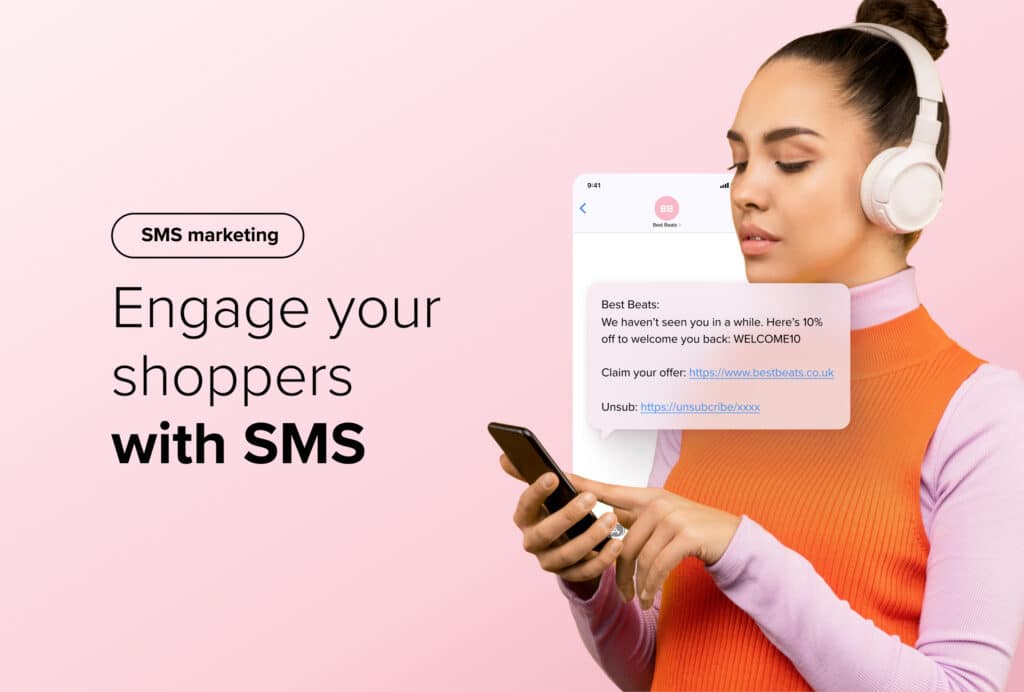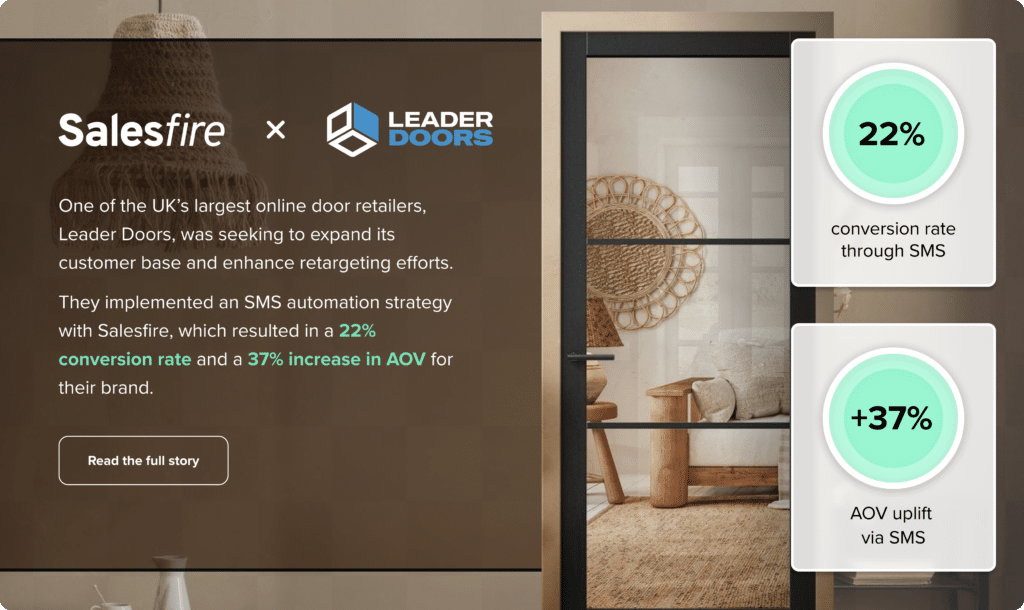Beginner’s Guide to SMS Marketing: What Online Retailers Need to Know
By Lucy Bedford • Last updated: Tuesday Mar 18th, 2025

SMS open rates can be as high as 98% compared to only 35% for emails, making SMS marketing a highly effective way to get noticed by your audience.1,2
The ease of access and affordability of modern email marketing platforms means most eCommerce brands are already sending some form of email content to their customers. However, SMS is often overlooked as a marketing tactic, leading to missed opportunities for retailers to secure sales from their shoppers.
SMS marketing enables retailers to reach consumers on the platform they use for most daily communication. With fewer retailers currently leveraging SMS than email, sending SMS from your brand can help you cut through the noise of your competitors and capture your shoppers’ attention.
But your SMS marketing should do more than just get shoppers to open your messages. To drive clicks and conversions that give your overall sales a boost, you will need to craft a strong SMS strategy and implement effective campaigns.
We can help you achieve this. In this article, we’ll cover the basics of SMS and how it fits into eCommerce, the advantages of SMS marketing for your brand, and how to build and send effective SMS campaigns that drive sales.
What is SMS? (Defining the Basics)
What does SMS mean?
In daily life, an SMS is more commonly referred to by most people as a text message. Most people, including you, will likely exchange many of these messages every day with friends and family.
What does SMS stand for?
SMS is an abbreviation of the phrase Short Messaging Service.
SMS is a service native to mobile phones, with new devices normally arriving pre-installed with an SMS messaging app. It’s a service that’s supported by all mobile networks, making it widely accessible.
What is an SMS message?
An SMS consists only of text and emojis. Short Messaging Service, or SMS, is aptly named as messages are typically limited to only 160 characters in length.
How does SMS work?
To send and receive SMS on a mobile device, users will require a SIM card that is connected to a mobile network.
The service operates using different channels to those used for a traditional voice call or connecting to the internet.3 This makes SMS reliable, as it can function even when there’s limited network coverage or network congestion.
Here’s the process a sent SMS goes through before it’s received on the recipient’s device:
- The sender inputs the recipient’s phone number and the message they want to send.
- Once the sender presses send, the message is sent to a central server called the Short Message Service Centre (SMSC).
- This server then uses the recipient’s phone number to determine which mobile network should be used to deliver the message and passes the message on to this network.
- The network then delivers this message to the recipient’s SMSC.
- The recipient’s device then connects to the SMSC and retrieves the message, which is displayed on their device.
What’s the difference between SMS and MMS?
If you regularly use your phone to send messages to your family and friends, you’ve probably received a message containing content such as a photo or video.
Since SMS can contain only text, this is made possible due to the existence of MMS.
MMS stands for Multimedia Messaging Service. Using MMS, you can send a variety of multimedia content, including audio clips, images, videos and GIFs.
Where an SMS is restricted to plain text and emojis, MMS provides more flexibility in the type of content you can send. However, MMS can be more costly than SMS, as network providers often charge more because of the additional data they use.
What is SMS marketing?
You now know what SMS is, but what does SMS marketing mean?
SMS marketing can be defined as the practice of using SMS to promote your brand’s products or services to your consumers and prospects.
The type of content you could send to your shoppers includes:
- Product launch announcements
- Exclusive discount codes
- Abandoned basket reminders
- Price drop notifications
- Back in stock notifications
Sending SMS marketing to your shoppers requires access to their mobile numbers. If you don’t currently store this data, check out our tips for collecting first-party data to help you build up your SMS list.
SMS marketing is also usually carried out on a much larger scale than standard SMS messaging. Standard SMS are usually sent to a single recipient, or several at most, whereas if you’re leveraging SMS marketing for your business, it’s likely you’ll want to send to hundreds or even thousands of recipients at once.
Sending to these large numbers will require the use of a bulk SMS sending tool such as Salesfire. These tools, designed for use by eCommerce retailers, allow for automation and can help you adhere to SMS best practices, which, as we discuss later in the article, are essential for maximising results.
SMS marketing vs. email marketing
As an online retailer, it’s likely you’ll already be sending marketing emails to your shoppers. You’re probably wondering what you can get from sending SMS that you can’t already achieve with email.
While it’s true that SMS and email marketing have many similarities, there are also many features that set them apart.
Both email and SMS marketing:
- Require consent: To send messages through both email and SMS channels, your recipients need to have opted in to receive marketing messages.
- Are owned channels: Unlike social media, where the platform is controlled by an algorithm, you have full control of who receives your SMS and email content, what that content is, and when it is delivered.
However, the functionality of email and SMS platforms and the way that consumers use these differ in ways such as:
- Ease of access: To receive emails, users must be logged in to their account and have an internet connection, but to receive SMS, they only need an active SIM card.
- Level of competition: There are fewer retailers sending SMS marketing than email marketing, so there’s less noise to cut through to get your SMS noticed by the recipient.
- Content type: Unlike email, SMS content is limited to 160 characters and cannot contain images, so SMS marketing requires more creativity to convey your message and drive action using this small space.
- Usage behaviour: Used for communicating with friends and family, SMS can be viewed by users as more urgent than email and, therefore, notifications are less likely to be muted and your message has more chance of being seen immediately.
Both SMS marketing and email marketing each offer unique advantages to eCommerce retailers, but they are most effective when used together as part of a multi-channel marketing approach. This way, your message will be reinforced and has an increased chance of capturing your shopper’s attention.
Benefits of SMS marketing
As we discussed in the previous section, SMS has many features that make it a unique marketing channel. It’s due to these features that SMS can be a great addition to your overall marketing strategy.
As an eCommerce retailer, SMS marketing can benefit your business by delivering:
- High open rates: We mentioned earlier in the article that SMS has an extremely high open rate of 98%. This means that with SMS, shoppers are very likely to see and read your content.
- Direct communication with shoppers: 90% of mobile phone owners frequently have their device with them, meaning with SMS marketing, you can reach shoppers directly, wherever they are.4
- Boosted engagement: The click-through rate of offer messages sent with SMS is 9.18% higher than any other digital channel.5 This means SMS content is likely to engage your shoppers and drive them towards taking the action you intend.
- Mobile-friendliness: With 64.04% of website traffic now coming from mobile devices, shoppers require their entire experience with your brand to be optimised for mobile.6 As SMS is native to mobile phones, any messages you send using this format are already guaranteed to be mobile-friendly.
Looking at these SMS marketing stats, it’s easy to see why online retailers are beginning to shift their focus onto using SMS within their marketing strategies.
SMS in eCommerce
From encouraging new visitors to make their first purchase to nurturing loyal shoppers, SMS marketing has many uses within the eCommerce industry.
Here are some SMS marketing solutions you can use to build customer relationships and drive increased sales for your online store.
Shopper retargeting
SMS can be an effective way to retarget shoppers who visited your site and left without making a purchase. Shoppers may browse across many sites or could be searching for products on the go and could easily forget about items in their cart.
You can re-engage your shoppers by sending a text reminder about the product they searched for or left behind, inspiring them to return and finalise the purchase.
Time-sensitive offers
With SMS, your messages are delivered to the recipient immediately on their mobile device. This makes it a great channel to let shoppers know about sales or discounts that are only available for a short time.
When informing shoppers of flash sales or a limited-time free delivery deal, ensure you use messaging that generates a sense of urgency, to drive action and secure sales for your brand.
Customer nurturing
SMS can be used to build an initial relationship with shoppers who are yet to purchase from you, and it can also help to keep existing customers engaged with your brand.
Consider sending an exclusive discount code to new shoppers via SMS, as this could give them the motivation to purchase a product they’ve had their eye on. Meanwhile, you could reward loyal shoppers by letting them know about product launches in advance or providing exclusive sale access.
SMS marketing can integrate easily with your existing buying funnel to reach and engage with shoppers at every stage of the customer lifecycle.
How to get started with SMS marketing
If you’ve never used SMS to market your eCommerce business before, the prospect can seem daunting. That’s why we’ve put together a step-by-step guide to walk you through the process of setting it up.
To begin using SMS marketing, here’s what to do.
1. Define your goals
Before you start collating any data or utilising any SMS-sending tools, you need to develop clear goals for what you want to achieve with the channel.
Consider whether you’d like to acquire more new customers, improve customer retention, or even just boost engagement.
These goals can help you to stay focused, as with a new channel, it can be easy to get disheartened if you don’t see results immediately. With a specific target in mind, you can see the real difference the channel is making.
Consider setting goals using the SMART format to ensure they are specific, measurable, achievable, relevant, and time-bound. Using this format ensures your goals follow a structure and you have clarity about exactly what they are.
2. Build a subscriber list
Without a list of mobile numbers to send to, you won’t be able to carry out any SMS marketing. Therefore, you need to collect this data.
You must do this ethically, complying with data protection regulations such as PECR and GDPR and ensuring that recipients have explicitly opted into receiving your marketing messages via SMS.
Using incentivised data collection methods can help you capture more mobile addresses from shoppers on your site. For example, try offering a monetary discount when a visitor inputs their mobile number.
Data capture technologies like Salesfire can implement these tactics on your site to capture mobile numbers from even more of your visitors, helping you to grow your SMS lists at scale.
Additional reading: See how Salesfire captured SMS data from 62% of Cater 4 You’s email subscribers in the Salesfire & Cater 4 You Success Story.
3. Segment your audience
To ensure your shoppers receive messaging tailored to their individual needs and interests, you will need to segment them.
This involves dividing your shoppers up based on additional data such as demographic information, purchase history, on-site behaviour, or interests.
You could group shoppers who haven’t purchased in over 6 months and send them an SMS with a discount code to encourage them to return to the buying funnel.
SMS retargeting tools like Salesfire can help make segmentation easier using automation. For example, if a shopper abandons their basket, an SMS will automatically be triggered for that specific user to remind them of the item they left behind.
4. Create engaging content
With the small character limit of SMS marketing, you need to be strategic with the message you send to your shoppers.
Your message should be concise and get to the point immediately, without using overly descriptive or excessive words. Incorporate emotive language alongside a clear call to action that tells users exactly what they need to do next.
Keeping your message simplistic and emotive ensures it is engaging to your shoppers and drives the action you want them to take, such as visiting your site to browse a sale.
By following these steps, you are sure to be on your way to crafting an effective SMS marketing strategy that drives real results.
Best practices for SMS success
Although there is no dedicated spam folder for SMS, recipients can still report you as spam or block you from sending messages to them completely. This means you need to take care the SMS you send are relevant and appropriate so that your content will continue to reach your shoppers.
Therefore, to reduce annoyance and maximise engagement with your SMS, it’s essential you follow the best practices for sending SMS marketing.
Delivery time
It’s considered inappropriate to send SMS marketing during quiet hours, which is classed as after 8pm on an evening and before 9am on a morning.
Outside of these hours, it’s been found that sending SMS during the lunch hours of 12pm-2pm yields the highest engagement rate, at 25%.7
Using an SMS marketing tool like Salesfire helps you to comply with these quiet times by allowing you to set restrictions on delivery times. Even if an SMS is triggered outside of these hours, it will not be sent to the recipient until the chosen time.
Frequency of messages
Similar to email, if a shopper receives an influx of SMS from your brand, it’s likely they will unsubscribe from receiving marketing content from you.
You must take care with the number of SMS you send. While you want to send regularly enough to maintain a relationship with the shopper and remind them your brand exists, you don’t want to be overwhelming.
Sending SMS marketing once or twice a week can help you achieve this balance.
Personalised content
Customers are more likely to engage with content that is relevant to them, so personalising your SMS sends can help to drive more opens, clicks, and conversions.
To grab the recipient’s attention, you could include their first name in the introductory line of the SMS. This can be done automatically with a bulk SMS sending service, even if you’re delivering SMS to hundreds of contacts.
Make sure the message holds the recipient’s attention by including content appropriate to the type of products they are interested in or their purchase history. For example, you could send texts promoting a flash sale to shoppers who tend to purchase items that are reduced in price.
Opt-out
Finally, always provide a way for users to opt out at the end of the SMS. This helps to ensure you only ever send to contacts who want to receive your messages.
By letting shoppers know they can unsubscribe at any time, they could also be more likely to stay subscribed as they know they can change their preferences whenever they want to.
You want to give shoppers a positive experience with your brand to drive purchases and by sticking to these guidelines, you’ll do just that.

The key message
As an eCommerce brand, you’ll already understand the importance of optimising your marketing strategy for mobile users. SMS marketing can help you to do this by delivering effective marketing messages that are optimised for the devices your shoppers use daily.
It’s clear from the figures that SMS marketing can provide an advantage to online retailers, especially when used alongside other marketing channels such as email. SMS marketing helps place your brand’s message right in front of shoppers, driving increased opens and improved engagement.
SMS marketing can be built into your existing marketing funnel, driving shoppers at every stage towards making a purchase with retargeting messages and content that nurtures both new and existing customers.
1 10 Reasons Brands Should Use Text Message Marketing | business.com
2 Good Email Open Rates: Key Things to Know | DesignRush
4 Americans’ Views on Mobile Etiquette | Pew Research Centre
5 35+ Must-Know SMS Marketing Statistics in 2024 | TechJury
6 Mobile Vs. Desktop Traffic Share & Trends | Digital Silk
7 Best Time to Send Text Messages: Optimizing Bulk SMS Campaigns for Maximum Engagement | Thriwin
Explore how SMS marketing can give your eCommerce business a boost, book a demo to try Salesfire today.



